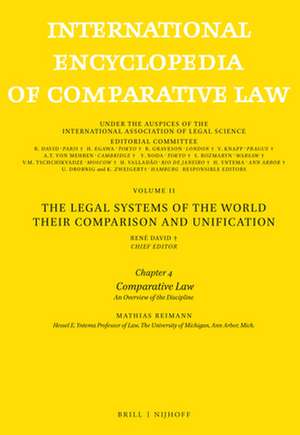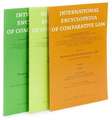International Encyclopedia of Comparative Law, Instalment 44: International Encyclopedia of Comparative Law, cartea 44
Editat de Mathias Reimannen Limba Engleză Paperback – 16 sep 2020
Preț: 721.99 lei
Preț vechi: 880.48 lei
-18% Nou
Puncte Express: 1083
Preț estimativ în valută:
138.17€ • 143.43$ • 115.21£
138.17€ • 143.43$ • 115.21£
Carte indisponibilă temporar
Doresc să fiu notificat când acest titlu va fi disponibil:
Se trimite...
Preluare comenzi: 021 569.72.76
Specificații
ISBN-13: 9789004424111
ISBN-10: 9004424113
Pagini: 268
Greutate: 0.63 kg
Editura: Brill
Colecția Brill | Nijhoff
Seria International Encyclopedia of Comparative Law
ISBN-10: 9004424113
Pagini: 268
Greutate: 0.63 kg
Editura: Brill
Colecția Brill | Nijhoff
Seria International Encyclopedia of Comparative Law
Notă biografică
Mathias Reimann, Dr. iur University of Freiburg (1982), LLM University of Michigan (1983), is Professor of Law and holder of the Hessel E. Yntema Chair at the University of Michigan. He has published numerous books and articles on private international law, comparative law, and legal history.
Cuprins
I. Introduction and Overview
A. Comparative Law DefinedB. Four Dimensions of the Discipline – Describing, Comparing, Mapping, and Tracing LawC. Three Pervasive QuestionsList of Principal Works
II. The Relationship with Other Disciplines
A. Comparative Law and other “International” SubjectsB. Comparative Law and “Social Science” Approaches to LawC. In Conclusion: Between Independence and InterdisciplinarityList of Principal Works
III. The Development of the Discipline
A. Comparative Studies Before 1800B. The Nineteenth-Century Foundations of Comparative LawC. The First Half of the Twentieth CenturyD. From World War II to the Fall of the WallE. The 1990s and BeyondF. In Conclusion: Major Accomplishments and the Loss of A Clear DefinitionList of Principal Works
IV. The Coverage of Comparative Law
A. Legal Systems of the WorldB. Elements of Legal SystemsC. Areas of Law 109D. In Conclusion: Proliferation and its Price
V. Goals And Uses of Comparative Law
A. Traditional Academic GoalsB. Traditional Practical UsesC. Modern AdditionsD. In Conclusion: The Strength and Downside of Goal PluralismList of Principal Works
VI. Orientations, Approaches, and Methods
A. Basic OrientationsB. General ApproachesC. Specific MethodsD. In Conclusion: A Mixed Methodological RecordList of Principal Works
VII. Twenty-First-Century Challenges
A. Adjusting to the “Age of Information” B. Coming to Grips with Global Legal PluralismC. Acknowledging Political Implications and ResponsibilityList of Principal Works
VIII. A Summary and Final Critique
A. Comparative Law DefinedB. Four Dimensions of the Discipline – Describing, Comparing, Mapping, and Tracing LawC. Three Pervasive QuestionsList of Principal Works
II. The Relationship with Other Disciplines
A. Comparative Law and other “International” SubjectsB. Comparative Law and “Social Science” Approaches to LawC. In Conclusion: Between Independence and InterdisciplinarityList of Principal Works
III. The Development of the Discipline
A. Comparative Studies Before 1800B. The Nineteenth-Century Foundations of Comparative LawC. The First Half of the Twentieth CenturyD. From World War II to the Fall of the WallE. The 1990s and BeyondF. In Conclusion: Major Accomplishments and the Loss of A Clear DefinitionList of Principal Works
IV. The Coverage of Comparative Law
A. Legal Systems of the WorldB. Elements of Legal SystemsC. Areas of Law 109D. In Conclusion: Proliferation and its Price
V. Goals And Uses of Comparative Law
A. Traditional Academic GoalsB. Traditional Practical UsesC. Modern AdditionsD. In Conclusion: The Strength and Downside of Goal PluralismList of Principal Works
VI. Orientations, Approaches, and Methods
A. Basic OrientationsB. General ApproachesC. Specific MethodsD. In Conclusion: A Mixed Methodological RecordList of Principal Works
VII. Twenty-First-Century Challenges
A. Adjusting to the “Age of Information” B. Coming to Grips with Global Legal PluralismC. Acknowledging Political Implications and ResponsibilityList of Principal Works
VIII. A Summary and Final Critique






